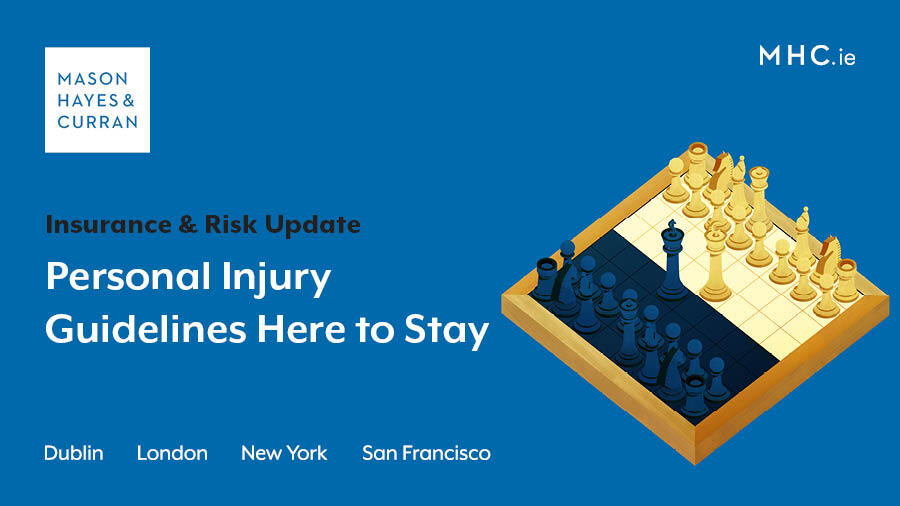Personal Injury Guidelines Here to Stay

The Supreme Court has delivered a long-awaited decision on the future of the Personal Injury Guidelines. Our Insurance & Risk team discusses the key points related to the complex judgments and how the decision will bring welcome clarity for insurers and claimants alike.
An eagerly awaited Supreme Court decision on the Personal Injury Guidelines was delivered on 9 April 2024. We summarise the five complex judgments which ultimately confirm, by majority, that the Guidelines are here to stay.
Background
Brigid Delaney brought a High Court case in 2022 against the Personal Injuries Assessment Board (PIAB) and Others[1]. In simple terms, Ms Delaney’s case was two-fold:
- She sought to challenge the constitutionality of the way that the Personal Injury Guidelines came into force
- She sought to challenge the way PIAB applied the Guidelines when they assessed her award for general damages
The underlying personal injuries at the centre of Ms Delaney’s claim arose from an accident that occurred in 2019.
The High Court initially ruled against Ms Delaney. She then appealed directly to the Supreme Court, given that the case concerned a matter of general public importance.
The Supreme Court’s decision
Five complex judgments were delivered by the Court on 9 April 2024.
The majority of the Court, with Mr Justice Hogan and Mr Justice Whelan dissenting, confirmed that the Guidelines have legal effect and remain binding.
1. The constitutional challenge
Under the Judicial Council Act 2019 (the 2019 Act), the Judicial Council was given certain powers including to adopt guidelines concerning sentencing and personal injuries. The Personal Injury Guidelines were introduced on foot of a vote of the Judicial Council in March 2021. The majority of the Court found that section 7(2)(g) of the 2019 Act, which provided for the adoption for the Guidelines, went too far in interfering with judicial discretion and on that basis they found that it was unconstitutional.
The Court went on to note, however, that the enactment of the Family Leave and Miscellaneous Provisions Act 2021 cured this issue. It was deemed that Oireachtas had independently approved the Guidelines into law and gave them legal standing.
2. The way in which PIAB assessed Ms Delaney’s claim
Ms Delaney had also argued that PIAB had delayed in assessing her claim which was submitted to them in June 2019. The usual time limit for PIAB to assess a claim is 12 months. By the time her claim was assessed, the Guidelines had been introduced. PIAB assessed her claim under the Guidelines rather than the old regime of the Book of Quantum. This resulted in a substantially lesser value being awarded for her injuries. The injury was valued at €3,000 as opposed to a potential award under the Book of Quantum of between €18,000 and €34,000.
The Court looked at the transitory provisions which essentially mean that PIAB has to assess all cases by reference to the Guidelines from the date of their introduction on 24 April 2021. If a case had not been assessed by PIAB prior to that date, the Personal Injury Guidelines would apply. The Court held that no one has a vested property or personal right to have their case adjudicated under the Book of Quantum. On that basis, the regime can change and there is no entitlement to a certain level of damages.
Costs
Despite the fact that Ms Delaney’s appeal was dismissed, the Court awarded her the costs of both the High Court and Supreme Court action, given the importance of the issue under appeal.
Comment
As the three-year anniversary of the introduction of the Personal Injury Guidelines approaches, they are now due to be reviewed.
Given the finding of the court that section 7(2)(g) of the 2019 Act is unconstitutional, a legislative amendment may be required if any changes to the Guidelines are recommended on foot of that review. What is certain from the majority decision of the Supreme Court is that the Guidelines are here to stay, which provides some welcome certainty for insurers and claimants alike!
For more information and expert advice on successfully defending your organisation’s interests in the context of personal injury claims, please contact a member of our Insurance & Risk team.
People also ask
What are the Personal Injury Guidelines? |
The Personal Injury Guidelines set out levels of damages that a particular injury can attract. The Guidelines identify a particular injury type and break it down by severity and various other factors. The Guidelines are used in order to assess an award for personal injuries claims. |
When did the Personal Injury Guidelines come into force? |
24 April 2021 |
What happens when a law is declared unconstitutional? |
Where a law is found to be unconstitutional, the courts are authorised to declare it null and void. This will typically be on a prospective rather than a retrospective basis, in that, this nullity will usually only take effect from the date the court declared the law unconstitutional. |
What is PIAB? |
PIAB (now known as Personal Injuries Resolution Board) is a Government body tasked with assessing and authorising personal injury claims at an initial stage pre-litigation. The purpose of the Board is to avoid a case going to the litigation process. A personal injuries case cannot be taken without first going to PIAB and getting an authorisation from them. |
The content of this article is provided for information purposes only and does not constitute legal or other advice.
[1] Bridget Delaney v The Personal Injuries Assessment Board, The Judicial Council, Ireland and The Attorney General.
Share this:




